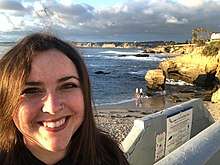Skype a Scientist
Skype a Scientist is a nonprofit educational organization based in Willimantic, Connecticut[5] that enables scientists to video conference with students in classrooms. It began as an informal program in 2017, founded by Sarah McAnulty while she was a graduate student at the University of Connecticut. As of 2019, almost 15,000 classrooms and over 7,000 scientists from a total of 43 countries had participated in video conferencing sessions.
| Founded | 2017[1] |
|---|---|
| Founder | Sarah McAnulty[2] |
| Purpose | Nonformal learning |
Region | International, through the Internet |
Key people | Sarah McAnulty, Executive Director[3] |
Staff | 3[4] |
Volunteers | 1,000+ |
| Website | www |
History

Sarah McAnulty came up with the idea for Skype a Scientist in 2016 while she was a graduate student in molecular and cell biology[6] at the University of Connecticut in Storrs. Inspiration for the program came from the growing distrust of scientists and the rise of anti-intellectualism in US society.[7] McAnulty was concerned that scientists were portrayed in media as "cold and calculating"[8] and aimed to connect people with scientists through video conferencing to dispel those stereotypes, and to "get people trusting scientists again".[9]
In 2017, McAnulty matched volunteer scientists with teachers and classrooms by hand using a Google spreadsheet, which she shared repeatedly on Twitter and Tumblr. She collected information from scientists and teachers and matched them based on their time zones and type of scientist requested if available.[10][8][lower-alpha 1] As the program grew, McAnulty recruited her childhood friend, David Jenkins, a graduate student in bioinformatics at Boston University, to write an algorithm that could match scientists with classrooms automatically.[8]
As of 2020, Skype a Scientist is a registered 501(c)(3) non-profit, registered as part of Sarah Mack Scicomm, Inc.[5]
Video conferencing programs
Skype a Scientist's primary project is to provide classrooms of students a video conference with a scientist. Instead of a lecture, the video calls are informal question and answer sessions that last between 30 minutes and 1 hour. Skype a Scientist hopes that this allows students to "meet" scientists, and have their questions answered.[11]
During the first half of 2017, 800 scientists were matched with K-12 classrooms in almost all US states and in 27 other countries.[12] By July 2017, 1,740 classrooms had signed up to be matched during the following academic term. At the same time, 1,755 scientists had volunteered from all 50 US states and 17 other countries across 12 time zones.[9] By February 2019, a total of 14,312 classrooms had been matched with over 7,000 scientists. Participants were from 43 countries and sessions occurred in 14 languages, including American Sign Language.[7]
In 2018, scientists were placed into 28 categories based on their discipline, such as marine biology or computer science.[8] Skype a Scientist also tries to pair students of minority groups with scientists that share the same identity.[7][12]In 2018, McAnulty stated that sessions are free to schools.[8]
Because some classrooms with poor connections could not access video conferencing tools, Skype a Scientist began a program called "Skype a Scientist Live", where sessions are held over YouTube's live streaming feature. Questions are submitted beforehand and during the stream, and sessions are recorded for later playback.[7] By 2019, video conferencing sessions had expanded beyond schools to correctional facilities and book clubs.[10]
Other programs
"Drunk Scientist Trivia" nights are held at bars in Connecticut, where people can participate in hands-on science activities such as looking through microscopes. Additionally, "Skype a Scientist After Hours" allows adults that support the organization through Patreon to converse with scientists.[7]
Skype a Scientist is funded through direct donations and the subscription service Patreon.[7]
References
- Killgrove, Kristina. "How The 'Skype A Scientist' Program Combats Fake News Through Public Education". Forbes. Retrieved 2020-01-27.
- "Contact Our Team". SKYPE A SCIENTIST. Retrieved 2020-01-27.
- "Contact Our Team". SKYPE A SCIENTIST. Retrieved 2020-01-27.
- "Contact Our Team". SKYPE A SCIENTIST. Retrieved 2020-01-27.
- "Charity Navigator - Unrated Profile for Sarah Mack Scicomm Inc". Charity Navigator. Retrieved 2020-01-27.
- Galvin, Claire (18 Dec 2017). "UConn scientist uses Skype to teach". The Chronicle. Retrieved 27 Jan 2020.
- Killgrove, Kristina (27 Feb 2019). "How The 'Skype A Scientist' Program Combats Fake News Through Public Education". Forbes. Retrieved 2020-01-26.
- Poppick, Laura (20 Sep 2018). "The squid biologist connecting schools and scientists worldwide". Nature: d41586–018–06772-9. doi:10.1038/d41586-018-06772-9. ISSN 0028-0836.
- Krieger, Kim (25 Sep 2017). "Skype a Scientist". UConn Magazine. Fall 2017.
- Saylor, Zoe (12 Sep 2019). "People who don't trust scientists might just need to Skype one". Grist. Retrieved 2020-01-27.
- Tarantola, Andrew (7 Mar 2019). "Social media is revolutionizing how scientists interact with the public". Engadget. Retrieved 2020-01-27.
- Franz, Julia (22 July 2017). "What does a scientist look like? The 'Skype a Scientist' program helps schoolkids find out". Public Radio International. Retrieved 2020-01-26.